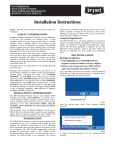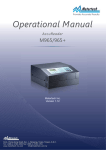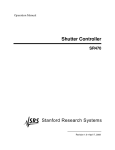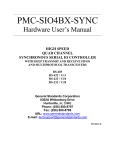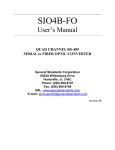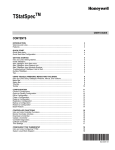Download Bryant SYSTMBBSAM01 User's Manual
Transcript
Installation and Start-Up Instructions EVOLUTION SYSTEM ACCESS MODULE SYSTMBBSAM01 Cancels: NEW II SAM01-0-1 05-05 . When you see this symbol on This is the safety-alert symbol the equipment and in the instruction manual, be alert to the potential for personal injury. Understand the signal words DANGER, WARNING, and CAUTION. These words are used with the safety-alert symbol. DANGER identifies the most serious hazards, which will result in severe personal injury or death. WARNING signifies a hazard, which could result in personal injury or death. CAUTION is used to identify unsafe practices, which may result in minor personal injury or product and property damage. NOTE is used to highlight suggestions which will result in enhanced installation, reliability, or operation. INSTALLATION CONSIDERATIONS Evolution System Access Module SYSTMBBSAM01 Before the actual installation of a System Access Module can begin, determine the mounting location. A radio test must be performed with the System Access Module in the intended mounting location. See below on how to perform a radio test. The System Access Module is powered with a 24 VAC transformer (included). A 120VAC supply must be near the mounting location of the System Access Module. Provisions must be made to secure the transformer to the outlet. The D-wire (24 VAC) from the Evolution system MUST NOT be used to power the System Access Module. Use this instruction to guide the actual installation process after the Evolution system(s) have been installed. One System Access Module is capable of handling two Evolution systems. A97038 NOTE: Read the entire instruction manual before starting the installation. This symbol → indicates a change since the last issue. TABLE OF CONTENTS SAFETY CONSIDERATIONS .....................................................1 INSTALLATION CONSIDERATIONS .......................................1 INTRODUCTION ..........................................................................1 INSTALLATION........................................................................1-3 Check Equipment and Job Site...........................................1 Component Location and Wiring Considerations ..............2 Connect Power Source ........................................................2 Radio Test............................................................................2 Install Components ..............................................................2 Connect Evolution Systems ................................................2 Connect Water Sensor.........................................................2 System Start-Up...................................................................3 PIN Number.........................................................................3 INTRODUCTION An Evolution System Access Module allows remote connectivity for up to two Evolution systems within the same building. The Evolution system owner as well as authorized dealer can monitor and control the system via the internet as well as by telephone. The System Access Module communicates through a two-way radio via the Skytel paging network. Please visit: http://www.skytel.com/coverage/telemetry_coverage.htm to check coverage for the installation site. The coverage must be listed as ″Full Service″ for the System Access Module to function properly. Please note that Skytel is continuously expanding their service area so coverage may not be indicated by the web site. The System Access Module can also monitor a dry-contact sensor to provide a warning for the presence of water in the building, or some other use. If the sensor is active, the Evolution system will not be disabled or shut down. RS-232 Connector ..........................................................................3 Updating System Profile ................................................................3 Troubleshooting..............................................................................3 SAFETY CONSIDERATIONS Improper installation, adjustment, alteration, service, maintenance, or use can cause fire, electrical shock, or other conditions that may cause personal injury or property damage. Consult a qualified installer, service agency, or your distributor or branch for information or assistance. The qualified installer or agency must use factory authorized kits or accessories when modifying this product. Refer to the individual instructions packaged with the kits or accessories when installing. Follow all safety codes and wear safety glasses. Have fire extinguisher available. Read these instructions thoroughly and follow all warnings or cautions attached to the unit. Consult local and state building codes and Sheet Metal and Air Conditioning National Association (SMACNA) for special installation requirements. INSTALLATION I. CHECK EQUIPMENT AND JOB SITE INSPECT EQUIPMENT — File claim with shipping company, prior to installation, if shipment is damaged or incomplete. —1— II. COMPONENT LOCATION AND WIRING CONSIDERATIONS If the Red LED is lit solid, then the System Access Module failed to send the message. Try a new mounting location for the System Access Module. If the Yellow LED is lit solid, then the System Access Module sent its message but did not receive a reply. The Bryant server may be down or the received signal is weak. Try a new mounting location for the System Access Module. Aborting Test - There is no method to abort a radio test once it is started, other than to remove power. The LEDs will maintain their state for 1 hour after the test. Pressing the Radio Test button momentarily will clear the LEDs. Pressing the Radio Test button again for five seconds will repeat the radio test. See Fig. 2 for a description of the radio test and LED sequence. WARNING: ELECTRICAL SHOCK HAZARD Failure to follow this warning could result in personal injury, death, or possible equipment damage. Disconnect supply power before routing wire. NOTE: All wiring must comply with national, state, and local codes. LOCATING SYSTEM ACCESS MODULE — Since the System Access Module (SAM) uses two-way radio, choose a potential mounting location that is as high and as close to outside walls or windows as possible to attempt to maximize radio coverage. The coverage is dependent on where the Skytel transceivers are located. If one location does not work, try the opposite side to get the device in closer directional proximity. Temporarily mount the System Access module in the intended permanent mounting location until the radio test has passed 100%. The System Access Module is approved for indoor use only and should never be installed with any of its components exposed to the elements. The System Access Module may be installed in any area where the temperature remains between -4° and 158°F and there is no condensation. The cover must be installed to prevent damage from other sources. Do not locate where it will be accessible to children. The SAM should be mounted in the vertical position. Remember that wiring access and Skytel reception are the most important considerations. Select a location near the Evolution furnace or fan coil where wiring from the User Interface, each Remote Room Sensor or Smart Sensor, each damper actuator, and the equipment itself can come together easily. V. INSTALL COMPONENTS INSTALL SYSTEM ACCESS MODULE — Once the radio test has passed, the System Access Module can be permanently installed. The System Access Module is designed so that wires can enter it from behind, above, or below. Plan wire routing before mounting. 1. Remove cover to access mounting holes. 2. Mount back plate to wall using screws and wall anchors provided. 3. Level back plate and tighten screws. VI. CONNECT EVOLUTION SYSTEMS CAUTION: UNIT OPERATION HAZARD Failure to follow this caution may result in improper unit operation. Improper wiring of the ABC connector will cause the System Access Module to operate improperly. Check to make sure all wiring is correct before proceeding with installation or turning on power. CAUTION: ELECTRICAL OPERATION HAZARD Failure to follow this caution may result in equipment damage or improper operation. To prevent possible damage to the System Access Module, do not mount on plenum, duct work, or flush against furnace. Connect the A, B, and C wires from the Evolution System to terminals labeled A1, B1, and C1. Connect the second Evolution System (if present) to the terminals labeled A2, B2, and C2. ABC bus wiring only requires a three wire connection; however, it is good practice to run thermostat cable greater than three wires in the event of a damaged or broken wire during the installation. It is recommended that the following color code be used when wiring each ABC connector: A — Green Data A B — Yellow Data B C — White 24VAC (Com) NOTE: The D-wire (red - 24 VAC hot) from the Evolution system is not connected to the System Access Module. It is not mandatory that the above color code be used, but each ABC connector in the system MUST be wired consistently. WIRING CONSIDERATIONS — Ordinary thermostat wire is ideal when wiring the System Access Module (shielded cable is not necessary). Use 22 AWG or larger for normal wiring. Lengths over 100 ft. should use 20 AWG or larger wire. III. CONNECT POWER SOURCE AND ANTENNA Screw the antenna to the radio connector. See Fig. 3 for antenna attachment location. A separate 24 VAC transformer is included to power the System Access Module. DO NOT connect the D-wire (24 VAC hot) from the Evolution system. The transformer is heavy. Make sure it is secured to the power outlet with an appropriate screw through the boss on the transformer. IV. RADIO TEST VII. CONNECT AUXILIARY SENSOR (OPTIONAL) The System Access Module will support a dry contact sensor for use with water detection or some other use as seen fit. Connect one side of the contacts to connector AUXC (common) and the other side to connector AUX (input). The sensor input can provide up to 20mA at 5 volts d.c. If the sensor input is active, it will not shut down or affect operation of the HVAC system(s). A pop-up message will appear on the user interface indicating the auxiliary sensor is active. The home owner will also be notified via e-mail and/or phone if so chosen on the internet web interface. The purpose of this test is to verify effective 2-way communications at the installation site. The test must pass 100% before the installation of the SAM can continue. Press and hold the RADIO TEST button for at least 5 seconds. A flashing Yellow LED will indicate the test is in progress. A flashing Yellow and Green LED means the transmission is complete and the System Access Module is waiting for a reply. A constant Green LED means the radio test has passed. The radio will perform three message tests, so this sequence will occur three times. If the System Access Module has errors during the process, the test could take up to 15 minutes. VIII. SYSTEM START-UP After a successful radio test has occurred, power may be applied to the Evolution System(s). The user interface of the Evolution System will automatically find the System Access Module at —2— Updating System Profile The Evolution System will automatically send system information to Bryant’s computer servers within one hour after the system has been successfully installed. Access to the system via the internet or telephone will not be available until this occurs. The system can be forced to send its information through the following process if internet and telephone access is required immediately. Press and hold the RADIO TEST button for 15 seconds. When the button is first pressed, the red LED will turn on. Five seconds into the press, the yellow LED will turn on. 15 seconds into the press, the green COM1 LED will turn on. Release the button when the green LED turns on. The red LED will flash when messages are being sent. The red and yellow LED will flash when the SAM is waiting for message replies. Upon successful profiling, both green LEDs will be lit. If profiling is not successful, the red LED will be lit solid. The entire profiling process can take up to 15 minutes per Evolution System. If two systems are connected to one SAM, then the profiling process can take up to 30 minutes. If the Evolution system ABC wiring is moved from connector 1 to connector 2 (or vice versa), or Evolution equipment has changed, the System Access Module must update Bryant’s servers with the new information. This will happen automatically within one hour, or can be manually forced with the process described above. TROUBLESHOOTING FAULT INDICATORS — Under normal operation, the Yellow and Green LED will be on continuously (solid). If the System Access Module does not receive communications with the Evolution system, the Green LED will not be on. If there are faults present, the Yellow LED indicator will blink a two digit status code. The first digit will blink at a fast rate, the second at a slow rate. power on. System installation screens will automatically appear and will display the Equipment Summary screen when finished. The Equipment Summary screen will display REMOTE ACCESS near the bottom of the screen. If REMOTE ACCESS is not displayed, check connections to the ABC wires as well as ensure the Yellow LED is lit on the System Access Module (this ensures the module has power). The green LED will be lit next to each ABC connection if the user interface has established communication. IX. PIN NUMBER AND SERIAL NUMBER The PIN and Serial number of the System Access Module are used by the system owner to register their system with Bryant. Remove the sticker containing the PIN number from the radio and install at the front of the Owner’s Guide. Also, write down the SAM serial number in the Home Owner’s Guide. The serial number can be found on the SAM packaging, at the bottom of the large SAM circuit board (see Fig. 3), or in the user interface Service Menu. If PIN number is lost or missing, it can be found by entering the Service Menu of the User Interface (10 second press of the Advance button) and looking at the Model/Serial Numbers screen. The PIN will be listed with the System Access Module model and serial numbers. RS-232 Connector An RS-232 port has been provided for connection to home automation equipment. Consult your home automation supplier for support. STATUS CODE —3— DESCRIPTION 45 Board Failure 61 Radio out of range (no coverage for five minutes) 62 Loss of communication with the radio 63 Radio not registered with the local network (unregistered for five minutes) 64 Auxiliary sensor active Send Message 1 (short) Flash Yellow at 1Hz Okay? Failed Green Yellow Red Green Yellow Red Green Yellow Red Green Yellow Red Green Yellow Red Green Yellow Red Green Yellow Red Green Yellow Red Green Yellow Red Green Yellow Red Green Yellow Red Green Yellow Red Green Yellow Red Flash Yellow at 1Hz and solid Red Wait for Reply (short) Flash Green and Yellow at 1 Hz Okay? Timeout Flash Green and Yellow at 1Hz and solid Red Send Message 2 (short) Okay? Flash Yellow 2 times, 1 second off Failed Flash Yellow 2 times and solid Red Wait for Reply (long) Okay? Flash Green and Yellow 2 times Timeout Flash Green and Yellow 2 times and solid Red Send Message 2 (long) Flash Yellow 3 times 1 second off Okay? Failed Flash Yellow 3 times and solid Red Wait for Reply (long) Glash Green and Yellow 3 times Okay? Timeout Glash Green and Yellow 3 times and solid Red All tests passed Solid Green LED Yellow and Red off Fig. 2 — Radio Test Process and LED Sequence A05073 —4— PIN LABEL Antenna Connection RADIO Home Automation Connection (RS-232) AUXILIARY SENSOR ABC TO SYSTEM 1 ABC TO SYSTEM 2 WLS RADIOTEST WLSC A1 STATUS B1 COMM1 C1 A2 B2 COMM2 24VAC+ C2 24VAC- SERIAL NUMBER Fig. 3 — System Access Module Control Board A04224 —5— © 2006 Bryant Heating & Cooling Systems 7310 W. Morris St. Indianapolis, IN 46231 —6— Printed in U.S.A. IISAM0101si Catalog No. II SAM01-0-1







